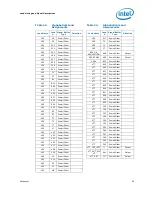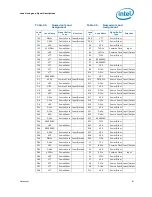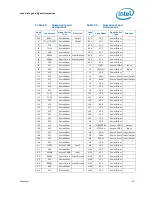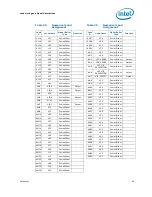
Land Listing and Signal Descriptions
Datasheet
73
DEFER#
Input
DEFER# is asserted by an agent to indicate that a transaction
cannot be ensured in-order completion. Assertion of DEFER# is
normally the responsibility of the addressed memory or input/
output agent. This signal must connect the appropriate pins/lands
of all processor FSB agents.
DRDY#
Input/
Output
DRDY# (Data Ready) is asserted by the data driver on each data
transfer, indicating valid data on the data bus. In a multi-common
clock data transfer, DRDY# may be de-asserted to insert idle clocks.
This signal must connect the appropriate pins/lands of all processor
FSB agents.
DSTBN[3:0]#
Input/
Output
DSTBN[3:0]# are the data strobes used to latch in D[63:0]#.
DSTBP[3:0]#
Input/
Output
DSTBP[3:0]# are the data strobes used to latch in D[63:0]#.
FCx
Other
FC signals are signals that are available for compatibility with other
processors.
FERR#/PBE#
Output
FERR#/PBE# (floating point error/pending break event) is a
multiplexed signal and its meaning is qualified by STPCLK#. When
STPCLK# is not asserted, FERR#/PBE# indicates a floating-point
error and will be asserted when the processor detects an unmasked
floating-point error. When STPCLK# is not asserted, FERR#/PBE# is
similar to the ERROR# signal on the Intel 387 coprocessor, and is
included for compatibility with systems using MS-DOS*-type
floating-point error reporting. When STPCLK# is asserted, an
assertion of FERR#/PBE# indicates that the processor has a
pending break event waiting for service. The assertion of FERR#/
PBE# indicates that the processor should be returned to the Normal
state. For additional information on the pending break event
functionality, including the identification of support of the feature
and enable/disable information, refer to volume 3 of the Intel
Architecture Software Developer's Manual and the Intel Processor
Identification and the CPUID Instruction application note.
GTLREF[1:0]
Input
GTLREF[1:0] determine the signal reference level for GTL+ input
signals. GTLREF is used by the GTL+ receivers to determine if a
signal is a logical 0 or logical 1.
Table 26.
Signal Description (Sheet 1 of 9)
Name
Type
Description
Signals
Associated Strobe
D[15:0]#, DBI0#
DSTBN0#
D[31:16]#, DBI1#
DSTBN1#
D[47:32]#, DBI2#
DSTBN2#
D[63:48]#, DBI3#
DSTBN3#
Signals
Associated Strobe
D[15:0]#, DBI0#
DSTBP0#
D[31:16]#, DBI1#
DSTBP1#
D[47:32]#, DBI2#
DSTBP2#
D[63:48]#, DBI3#
DSTBP3#
Содержание CORE 2 DUO E4000 - 3-2008
Страница 8: ...8 Datasheet ...
Страница 10: ...10 Datasheet ...
Страница 36: ...Electrical Specifications 36 Datasheet ...
Страница 38: ...Package Mechanical Specifications 38 Datasheet Figure 9 Processor Package Drawing Sheet 1 of 3 ...
Страница 39: ...Datasheet 39 Package Mechanical Specifications Figure 10 Processor Package Drawing Sheet 2 of 3 ...
Страница 40: ...Package Mechanical Specifications 40 Datasheet Figure 11 Processor Package Drawing Sheet 3 of 3 ...
Страница 46: ...Package Mechanical Specifications 46 Datasheet ...
Страница 100: ...Features 100 Datasheet ...
Страница 110: ...Boxed Processor Specifications 110 Datasheet ...
Страница 122: ...Debug Tools Specifications 122 Datasheet ...






























